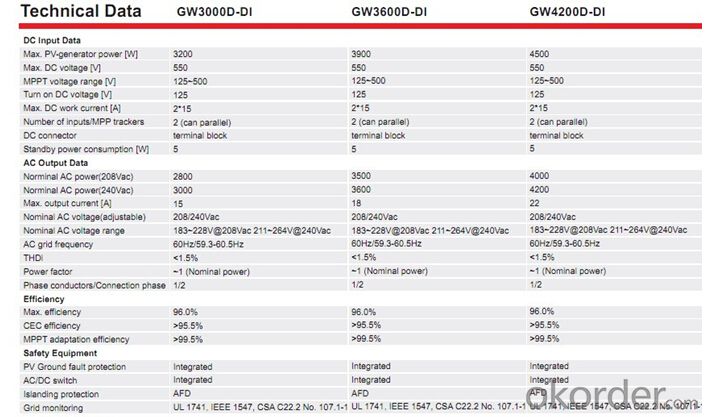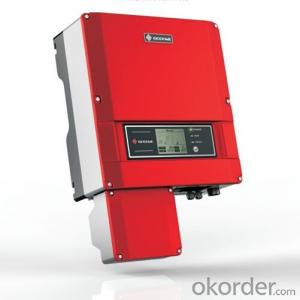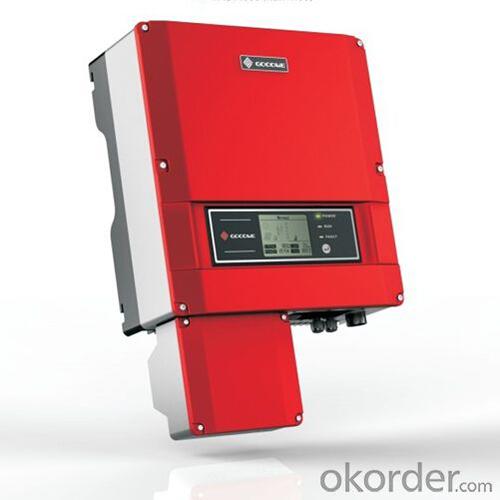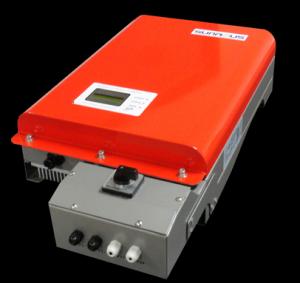Siemens Solar Inverter GW4200D-DI (High Frequency Isolated)
OKorder Service Pledge
OKorder Financial Service
You Might Also Like
GW3000/3600/4200D-DI (High Frequency Isolated) is the new on-grid PV inverter which integrated with most advanced technology, come with 10 years warranty,
and are designed to meet the new IEE1547 requirements for the North American market. Also it’s suitable for thick-film modules.
Easy installation and simple operation make them ideal for residential and small-to-medium commercial applications.
GoodWe inverters, with ever-increasing efficiency and high stability,
could ensure you better overall performance of solar power systems and shorter payback periods.
Datasheet

- Q: What is the role of a solar inverter in reactive power compensation?
- To regulate and control the flow of reactive power in a solar power system, a solar inverter plays a crucial role in reactive power compensation. The presence of inductive or capacitive elements in the system causes reactive power to oscillate between the source and load. Although this power does not contribute to the actual work done by the system, it is necessary for the operation of specific devices. A solar inverter, specifically designed for reactive power compensation, is capable of measuring the reactive power in the system and adjusting its operation accordingly. It has the ability to generate or absorb reactive power as needed to maintain a power factor close to unity. The power factor is a measure of the efficiency of electrical energy utilization, and a high power factor indicates efficient electricity usage. By compensating for reactive power, a solar inverter ensures that the solar power system operates at optimal efficiency. It alleviates the burden on the grid by locally supplying or absorbing reactive power instead of relying on the grid for compensation. This not only improves the overall quality of power but also reduces system losses. Furthermore, it helps stabilize voltage levels and minimize voltage fluctuations, which can be advantageous for delicate electrical equipment. In conclusion, the role of a solar inverter in reactive power compensation is vital for regulating the flow of reactive power in a solar power system, maintaining a high power factor, and improving overall system efficiency. It plays a pivotal role in ensuring the optimal operation of the solar power system and diminishing the dependence on the grid for reactive power compensation.
- Q: What is the role of transformerless design in a solar inverter?
- The role of transformerless design in a solar inverter is to eliminate the need for a bulky and expensive transformer, resulting in a more compact, lightweight, and cost-effective solution. Transformerless inverters use advanced electronic circuitry to convert the direct current (DC) generated by solar panels into alternating current (AC) that can be used to power household appliances or fed back into the grid. This design allows for higher efficiency, lower energy losses, and increased flexibility in system design and installation.
- Q: Can a solar inverter be used in three-phase systems?
- Yes, a solar inverter can be used in three-phase systems. In fact, there are specific three-phase solar inverters designed to convert the DC power generated by solar panels into AC power for utilization in three-phase electrical systems. These inverters are capable of efficiently managing the power flow and ensuring balanced distribution across all three phases.
- Q: Can a solar inverter be used with solar-powered agricultural equipment?
- Yes, a solar inverter can be used with solar-powered agricultural equipment. A solar inverter is an essential component in a solar power system as it converts the DC (direct current) electricity generated by solar panels into AC (alternating current) electricity that can be used to power various equipment, including agricultural machinery.
- Q: What are the potential risks of overvoltage in a solar inverter?
- The potential risks of overvoltage in a solar inverter include damaging the inverter itself, reducing its lifespan, and potentially causing a fire or electrical hazard. Overvoltage can also lead to the failure of other connected components, such as solar panels or batteries, and may even result in a complete system shutdown. It is crucial to implement protective measures, such as surge protectors or voltage regulators, to mitigate the risks associated with overvoltage.
- Q: What is the role of a DC-DC converter in a solar inverter?
- The role of a DC-DC converter in a solar inverter is to convert the direct current (DC) generated by the solar panels into the appropriate voltage and current levels required for the inverter to convert it into alternating current (AC) electricity. The DC-DC converter ensures efficient power transfer and enables the solar inverter to maximize the energy harvested from the solar panels. Additionally, it helps regulate the voltage levels and maintain the stability of the solar power system.
- Q: Can a solar inverter be repaired or serviced?
- Yes, a solar inverter can be repaired or serviced. Inverters are complex electronic devices that can experience faults or malfunctions over time. Depending on the issue, a qualified technician can diagnose and repair the inverter, replacing faulty components if necessary. Regular maintenance and servicing can also help identify potential problems and ensure optimal performance of the solar inverter.
- Q: What are the key factors affecting the installation process of a solar inverter?
- The key factors affecting the installation process of a solar inverter include the location and orientation of the solar panels, the size and capacity of the inverter, the electrical infrastructure of the building, the type of mounting system used, and compliance with local regulations and building codes. Additionally, factors such as shading, temperature, and maintenance accessibility should also be considered during the installation process.
- Q: Can a solar inverter be used in a solar-powered electric vehicle charging station?
- Yes, a solar inverter can be used in a solar-powered electric vehicle charging station. A solar inverter is responsible for converting the Direct Current (DC) generated by solar panels into Alternating Current (AC) that can be used to charge electric vehicles. Therefore, it is an essential component in a solar-powered EV charging station, allowing the electricity generated from solar panels to be compatible with the charging needs of electric vehicles.
- Q: Are there any noise or vibration concerns associated with solar inverters?
- Yes, there can be noise and vibration concerns associated with solar inverters, although they are generally minimal. Some older or lower-quality inverters may produce a humming or buzzing sound, especially when operating at high power levels. Vibrations can also occur due to the internal components and fans. However, modern inverters are designed to minimize noise and vibrations, and most people find them to be quiet and unobtrusive.
Send your message to us
Siemens Solar Inverter GW4200D-DI (High Frequency Isolated)
OKorder Service Pledge
OKorder Financial Service
Similar products
Hot products
Hot Searches
Related keywords

























